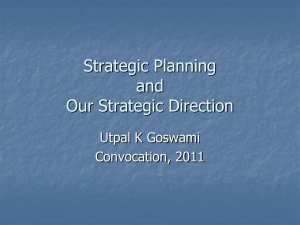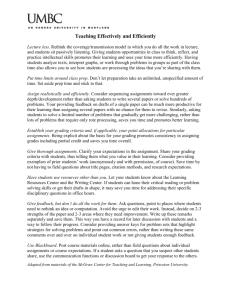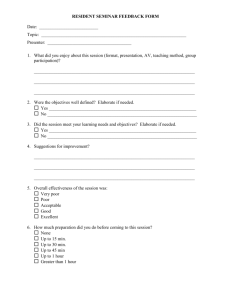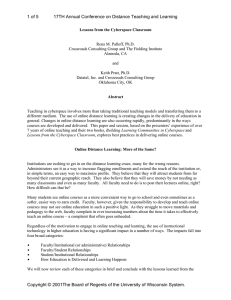STRETCH Model of Online Instruction (Dr. Kelvin Bentley)
advertisement
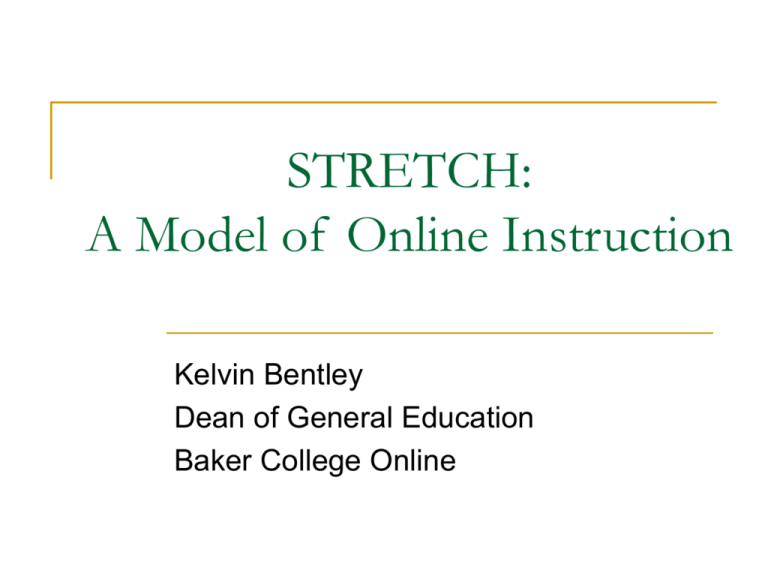
STRETCH: A Model of Online Instruction Kelvin Bentley Dean of General Education Baker College Online Overview Search “Tackle” Rethink Elaborate Transition Collaborate Hone Search Yourself Self-assessment Schedule Personality Technology knowledge Something to think about… “An instructor who is willing to use collaborative, active learning techniques and ideas, and who allows for personal interaction, brings in real-life examples, and builds reflective practice into teaching, is a good candidate for teaching online”. (Palloff and Pratt, 2002) “Tackle” New Technologies Instructional Design Software Programs Course Management Systems Adobe Acrobat Microsoft PowerPoint Macromedia’s Breeze Quarbon’s Viewlet Presenter Macromedia’s Robodemo Techsmith Camtasia Studio Blackboard Open-source? Streaming Other Options? Adapting Publisher Resources Rethink Syllabus Course Content Interactions Assignments Assessments Rethink Your Syllabus Specific Course Outcomes Textbook Information Contact Information Format Faculty Picture Email Phone Instant Messaging Word, HTML, Acrobat Other Resources Tutorials Web pages Rethink Content Development Content Development Options Intra-institutional Approach Content Expert, Instructional Designer, Faculty Trainer Inter-Institutional Approach Consortia Tennessee Board of Regents Online Degree Programs University of Texas TeleCampus UMassOnline Extra-Institutional Approach Learning Object Depositories MERLOT MIT’s OpenCourseWare ILumina Educational Resources for Math and Science Rethink Course Content Learning Styles ADA Compliance Bandwidth Issues Copyright Issues TEACH ACT and Using Blackboard Other issues? Example: What investments are necessary to design or develop content for your online courses? Elaborate Course Interactions Learner-Teacher Facilitating Discussion Board Postings Learner-Learner Small-group activities Learner-Guest or Expert Students contact experts in the community Learner-Tools Students using key features of Blackboard Learner-Content Students researching web page content Learner-Environment Students using online databases to research a paper (Hanna et al., 2000) Elaborate Assignments and Assessments Assignments Link assignments to clear learning objectives Develop rubrics Provide detailed feedback Assessments Use varied assessment formats Provide detailed feedback Use Proctors Proctoring Policy Guard against Plagiarism Example: Turnitin.com Transition into Online Instruction Teach any of the following types of courses: Web-enhanced Hybrid Online Collaborate Peer Mentoring Grant-funded course development Colloquia Hone the Quality of Your Instruction Student Evaluations Rubrics Accreditation Guidelines Resources Rubric for Online Instruction Distance Education Clearinghouse Conferences Conference on Distance Teaching and Learning A Reminder of the Goal “…the marriage of new electronic technologies and newly accepted theories of learning promised to yield a revolution in pedagogy itself. Learning would be customized, self-paced, and problem based. Course instructors would be replaced by designers and facilitators-the “sage on the stage” would become the “guide on the side.” Students would have the ability to model outcomes, conduct experiments based upon well-documented laboratory simulations, rapidly exchange ideas with fellow students and teaching faculty, and where appropriate, join global learning communities…” (Zemesky and Massy, 2004) References Hanna, D. E., Dudka, M. G., & Runlee, S. C. (2000). 147 Practical Tips for teaching online groups. Madison, Wisconsin: Atwood Publishing. Palloff, R. M., & Pratt, K. (2002). (Eds. K. E. Rudestam & J. Schoenholtz-Reed). Handbook of Online Learning, London: Sage Publications. Zemsky, R., & Massy, W. F. (2004). Thwarted innovation: What happened to e-learning and why. The Learning Alliance, The University of Pennsylvania. Questions and Further Discussion
